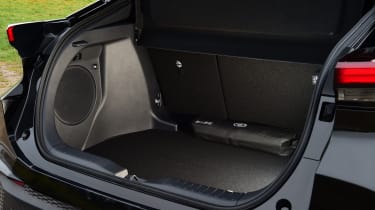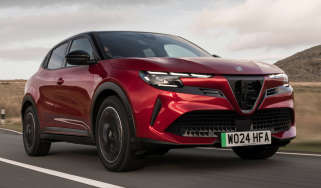Toyota C-HR review – Boot space, practicality & dimensions
“The C-HR’s stylish looks harm practicality, with a small boot and unwelcoming back seats”
There’s plenty of room for front occupants, but we were slightly disappointed with the second row given the C-HR’s SUV billing. Its back doors are pretty small for a start, making it harder to access the back seats or load in a bulky child car seat than in a rival like the Skoda Karoq.
Once in the back, head and legroom is only average, and the dark headlining, small windows and integrated headrests of the front seats all add up to a fairly claustrophobic feel. It’s a shame, because it makes the C-HR’s rear bench feel smaller and less accommodating than it actually is.
The C-HR’s coupe-style design also affects rear visibility to an extent, because while the rear windscreen is actually reasonably deep, the small rear side windows hamper your over-the-shoulder view. The swooping looks also mean you’re sitting a long way from the windscreen, which might be off-putting for some drivers.
|
Size comparison | |||
|
Model |
Length |
Width |
Height |
|
Toyota C-HR |
4,360mm |
1,830mm |
1,570mm |
|
Skoda Karoq |
4,382mm |
1,841mm |
1,612mm |
|
Hyundai Kona |
4,350mm |
1,825mm |
1,585mm |
|
Volvo EX30 |
4,233mm |
1,837mm |
1,555mm |
Does the Toyota C-HR have a big boot?
If you’re coming to the C-HR from a hatchback, its 388-litre (364 litres for the 2.0-litre version) boot will likely prove to be a sideways step in terms of practicality, but it’s quite a long way down on SUV rivals. The PHEV gets an even smaller 310-litre figure owing to its larger battery pack, which is smaller than most small cars and superminis now offer. If you need an SUV for shopping trips and weekends away, the C-HR should be fine, but it may prove frustrating for family holidays or moving bulky items around.
The Skoda Karoq might be in the same class, but it can carry 521 litres behind its rear seats, while the SEAT Ateca is only around 10 litres smaller. The C-HR’s boot also seems lacking in clever features, with a fixed height floor and rudimentary 60:40 split and fold rear seats. Some rivals offer sliding rear seats with 40:20:40 folding and reclining for added convenience and comfort, along with an adjustable floor to optimise the load space and handles inside the boot to flip the rear seats down.
|
Boot space comparison | |
|
Model |
Boot space |
|
Toyota C-HR |
388 litres |
|
Skoda Karoq |
512 litres |
|
Hyundai Kona |
466 litres |
|
Volvo EX30 |
318 litres |
Which Is Best?
Cheapest
- Name1.8 Hybrid Icon 5dr CVT
- Gearbox typeAuto
- RRP£31,440
Most Economical
- Name2.0 PHEV Design 5dr CVT
- Gearbox typeAuto
- RRP£39,230
Fastest
- Name1.8 Hybrid Icon 5dr CVT
- Gearbox typeAuto
- RRP£31,440
















